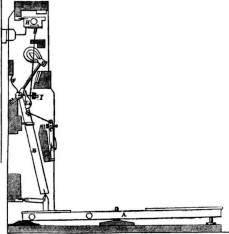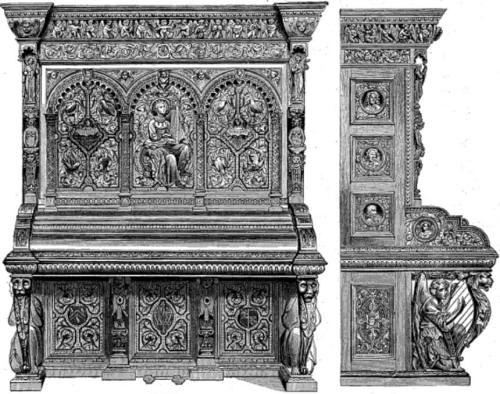home
| Pianoforte-makers
in England
ALLISON Ralph
in
London
|
The catholic directory and ecclesiastical register: for the year 1851, p. 20
Cassell's Illustrated Exhibitor: Containing about Three Hundred, 1862, p. 284
Cassell's Illustrated Exhibitor : Containing about Three Hundred, 1862, p. 104 - and - The illustrated record and descriptive catalogue of the Dublin international, 1865, p. 241
The entire design is made in accordance with the purpose of the instrument—namely, the production of musical sounds. Kneeling angels, playing upon harps, form the brackets for the support of the key board. Busts of Jubul, Miriam, and David, with carved portraits of Handel, Haydn, and Mozart, on enriched panels, form the ends; the cheeks having busts of singing angels, surrounded with richly-carved foliage. The lower portion of the front has three perforated panels, enriched with'armoniiil tarings, and the monogram of the owner, and is divided by two earyatide figures. The upper part is supported on each side by angels, cut in full relief, playing upon harps. Above are female figures, holding scrolls of music, which show the commencement of "Gloria in Excelsis." The centre is divided into three panels by richly-carved semi-detached pillars beneath circular arches, the centre key of which is a bust of Her Majesty. The panels themselves are all richly carved, and in the centre is St. Cecilia playing upon a hand organ. In the side panels are angels holding scrolls in their hands, with the legend, "Glory to God in the highest, and on earth peace." In the spandrils of these two side compartments are portraits, carved in full relief, of eight of the various British warblers, the nightingale, skylark, treelark, robin, linnet, blackcap, bullfinch, and goldfinch. The spandrils of the arches contain cherubim. The cornice is also elaborately pierced, so that every means has been taken to insure the full emission of sound. The lower frieze is of foliage, with small birds, and monogram intertwined. The large upper one is a choir of twentyseven angels, each playing upon a different musical instrument, from the earliest known example down to the most modern. The nameboard is richly chased with ornamental devices, and the monogram of the owner is again introduced in relief. "Wherever mouldings are required, they have been elaborately ornamented. The interior of the instrument has by no means been neglected, for three strings have been placed to each note, and the blow given by a new patent check escapement action. We understand that the value of this instrument is three hundred and fifty guineas. Messrs. Allison also exhibit a fine pianoforte, in walnut-tree and gilt mouldings, with carved pillar truss, and the new patent check action. They likewise show their "Improved London Model" pianoforte in rosewood. This is one of their ordinary instruments, suitable for the school-room and boudoir. In the fret-front there are no fewer than 675 holes, and it has the patented back and wrest plank, with registered key board. The price of such a piece of music is, we believe, £30; and for general practice no better piano is needed. A very curious and complicated affair is a piano. Its interior, to an uneducated eye, is a world of strings, and pedals, and strangelooking mechanism. The strings, stretched to the full amount of tension, give, we are told, a "pressure of several tons;" yet such is the ingenious arrangement of the machine, that the whole is brought into instant action by the slightest touch of a lady's finger. Of the relative merits of the various beautiful instruments shown on the British side, it is quite impossible to pronounce any opinion; but if their interior arrangements are as good as their exterior embellishments — and the power of musical sound constantly heard in the Exhibition warrants this belief — why, then, we may well conclude that there is assembled at South Kensington a collection of the finest instruments in the world. The strange names by which some of the pianos arc known will surely puzzle a non-professional visitor. For instance, we find one cottage-piano described as "tubulated," another as "equipollent," and a third as fitted with an anti-blocking hopper; while a "grand" is called a microchordou, and a "square" an "iron clipper plated," with propeller action. But all these have doubtless their peculiar excellences." Cassell's Illustrated Exhibitor : Containing about Three Hundred, 1862, p. 104
Illustrirter Katalog der Londoner Industrie-Ausstellung von 1862, Volumes 1-2, 1862, p. 40
Die Ausführung sich das Ausführung des Gehäuses gehört mit dem Besten dieser Art im ganzen Industriepalast. Die in ganzer Figur ausgearbeiteten, der Mitte, welche das Clavicembalo schlägt, die kleinen Engelstatuetten, der Fries mit seinen musicirenden Engelchen in Relief - Alles dies vereinigt sich zu einem so reichen, und doch harmonischen Ganzen, dass man schon daraus auf die Güte des Instruments selber schliessen zu dürfen glaubt." Illustrirter Katalog der Londoner Industrie-Ausstellung von 1862, Volumes 1-2, 1862, p. 40
This grand instrument was shown near the entrance to the musical court of the Exhibition, and was one of the most striking examples of the capabilities of mechanism for producing perfect music. On this wonderful instrument innumerable different effects, variations, and shades of tone can be produced; and the mechanism is so perfect that its action is instantaneous and free from noise. The instrument in itself is most durable, and so built as to be equally suitable either for the heat of Calcutta or the frost of Siberia. The barrels can be easily and conveniently removed from the front, and the orchestrion does not, therefore, require more space than its width. The deepest notes are placed in the centre of the instrument, so that the tuner can tune each pipe from sides without disturbing any portion. The speed can be regulated by an additional fly so as to give detailed effects to the music performing. Self-acting instruments have been constructed for centuries past, but have always borne the impression of the general knowledge of mechanism and music of the time being. Instead of simplicity of action, the most complicated and awkward designs were used, and, therefore, would have better been termed motionless, instead of self-acting instruments; but self-acting instruments are as sure to act as Orchestrion. [...] 320 Allison, R. & Sons, 108 Wardour st. Oxford st. W. and Werrington St. St. Pancras, N.W. — Pianofortes, models, &c." The illustrated record and descriptive catalogue of the Dublin international, 1865, p. 239-241
In this piano the escapement takes place (as in the grand piano) from the butt of the hammer, and a crisp touch is obtained which is rarely found in instruments of its class. Its price is 23l., and I consider this piano very remarkable as a combination of cheapness and excellence." Reports on the Paris Universal Exhibition, 1867, Volume 2, p. 199
For references see page
|





